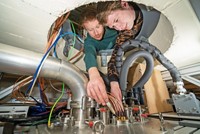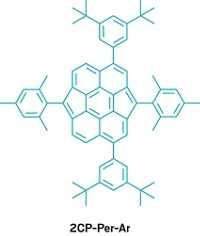Advertisement
Grab your lab coat. Let's get started
Welcome!
Welcome!
Create an account below to get 6 C&EN articles per month, receive newsletters and more - all free.
It seems this is your first time logging in online. Please enter the following information to continue.
As an ACS member you automatically get access to this site. All we need is few more details to create your reading experience.
Not you? Sign in with a different account.
Not you? Sign in with a different account.
ERROR 1
ERROR 1
ERROR 2
ERROR 2
ERROR 2
ERROR 2
ERROR 2
Password and Confirm password must match.
If you have an ACS member number, please enter it here so we can link this account to your membership. (optional)
ERROR 2
ACS values your privacy. By submitting your information, you are gaining access to C&EN and subscribing to our weekly newsletter. We use the information you provide to make your reading experience better, and we will never sell your data to third party members.
Physical Chemistry
Building A Bigger Nanocage
Nanomolecular Synthesis: Large, uniform molecular cages could aid the development of a quantum computer
by Erika Gebel Berg
June 17, 2015
“Big nanoparticles” may sound like an oxymoron, but they are sought after by chemists pursuing materials for superfast quantum computers of the future. However, nanoparticles with consistent, predictable structures are hard to make. Scientists have struggled to synthesize uniform batches of nanoparticles larger than 4 nm across, typically ending up with a hodgepodge of molecules. Now, researchers led by Richard E. P. Winpenny at the University of Manchester, in England, have developed a method to make batches of identical organometallic cages 8 nm across that could one day form the foundation of a quantum computer (J. Am. Chem. Soc. 2015, DOI: 10.1021/jacs.5b04664).

Quantum computers store information in quantum bits, or qubits. Unlike the bits in conventional computers, which store information in binary form as either a one or a zero, qubits can store information using many different states in a molecule. This ability could allow quantum computers to access phenomenally more computing power, whether to do bigger calculations or to compute things faster—although quantum computers are still an idea more than a reality. In previous work, Winpenny’s team developed an eight-membered ring made of chromium and nickel units with the right electronic structure to allow it to act as a qubit. But one qubit isn’t enough to do useful computation, he says, because the ability to perform many simultaneous calculations—one of the main advantages of quantum computing—requires many interconnected qubits. So the researchers tried to stitch together a bunch of their rings into a single, large nanostructure.
To bring the rings together, the researchers attached the unforked end of a Y-shaped molecule to each ring, Then they added palladium to the mix, which triggered the forked ends of the Y—made by two widely spaced pyridine groups—to form complexes around 12 palladium ions at the center of the molecule. The resulting structure was a shell made of a whopping 24 rings, corresponding to 24 qubits.
To study the novel molecule’s computing potential, the researchers measured a parameter called phase memory, using pulsed electron paramagnetic resonance spectroscopy. A longer phase memory indicates better computing potential because it suggests that the molecule’s quantum states are more stable and could therefore hold their information longer. The 24-ring structure had a phase memory of 350 nanoseconds, just shy of the 410 nanoseconds observed in a single ring, demonstrating that even though the molecule is more complex, its quantum states remain stable. “I didn’t expect the results to be anywhere near that good,” Winpenny says.
“It is really nice that they succeeded in constructing 8-nm-sized nanoparticles,” says Makoto Fujita of the University of Tokyo, particularly ones that were all the same size and thus functionally identical. However, Fujita says more work will be necessary for practical quantum computing. Winpenny agrees and is working to build a nanocage with 48 rings. Having 70 to 100 qubits in one molecule is the goal: “Then you could start doing some serious stuff,” he says.





Join the conversation
Contact the reporter
Submit a Letter to the Editor for publication
Engage with us on Twitter